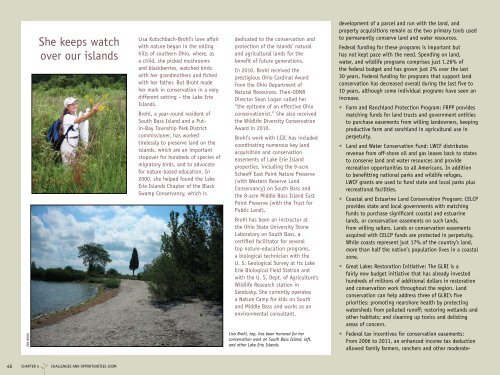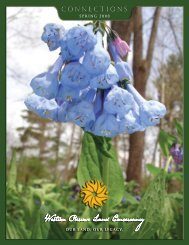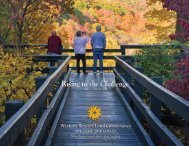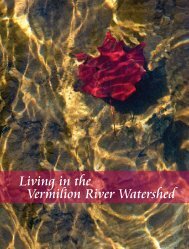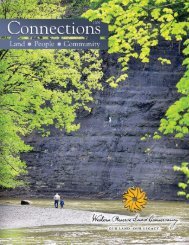Common Ground - Western Reserve Land Conservancy
Common Ground - Western Reserve Land Conservancy
Common Ground - Western Reserve Land Conservancy
Create successful ePaper yourself
Turn your PDF publications into a flip-book with our unique Google optimized e-Paper software.
KEN WOOD<br />
She keeps watch<br />
over our islands<br />
46 CHAPTER 5 CHALLENGES AND OPPORTUNITIES LOOM<br />
Lisa Kutschbach-Brohl’s love affair<br />
with nature began in the rolling<br />
hills of southern Ohio, where, as<br />
a child, she picked mushrooms<br />
and blackberries, watched birds<br />
with her grandmothers and fished<br />
with her father. But Brohl made<br />
her mark in conservation in a very<br />
different setting – the Lake Erie<br />
Islands.<br />
Brohl, a year-round resident of<br />
South Bass Island and a Putin-Bay<br />
Township Park District<br />
commissioner, has worked<br />
tirelessly to preserve land on the<br />
islands, which are an important<br />
stopover for hundreds of species of<br />
migratory birds, and to advocate<br />
for nature-based education. In<br />
2000, she helped found the Lake<br />
Erie Islands Chapter of the Black<br />
Swamp <strong>Conservancy</strong>, which is<br />
dedicated to the conservation and<br />
protection of the islands’ natural<br />
and agricultural lands for the<br />
benefit of future generations.<br />
In 2010, Brohl received the<br />
prestigious Ohio Cardinal Award<br />
from the Ohio Department of<br />
Natural Resources. Then-ODNR<br />
Director Sean Logan called her<br />
“the epitome of an effective Ohio<br />
conservationist.” She also received<br />
the Wildlife Diversity Conservation<br />
Award in 2010.<br />
Brohl’s work with LEIC has included<br />
coordinating numerous key land<br />
acquisition and conservation<br />
easements of Lake Erie Island<br />
properties, including the 9-acre<br />
Scheeff East Point Nature Preserve<br />
(with <strong>Western</strong> <strong>Reserve</strong> <strong>Land</strong><br />
<strong>Conservancy</strong>) on South Bass and<br />
the 8-acre Middle Bass Island East<br />
Point Preserve (with the Trust for<br />
Public <strong>Land</strong>).<br />
Brohl has been an instructor at<br />
the Ohio State University Stone<br />
Laboratory on South Bass, a<br />
certified facilitator for several<br />
top nature-education programs,<br />
a biological technician with the<br />
U. S. Geological Survey at its Lake<br />
Erie Biological Field Station and<br />
with the U. S. Dept. of Agriculture’s<br />
Wildlife Research station in<br />
Sandusky. She currently operates<br />
a Nature Camp for kids on South<br />
and Middle Bass and works as an<br />
environmental consultant.<br />
Lisa Brohl, top, has been honored for her<br />
conservation work on South Bass Island, left,<br />
and other Lake Erie Islands.<br />
development of a parcel and run with the land, and<br />
property acquisitions remain as the two primary tools used<br />
to permanently conserve land and water resources.<br />
Federal funding for these programs is important but<br />
has not kept pace with the need. Spending on land,<br />
water, and wildlife programs comprises just 1.26% of<br />
the federal budget and has grown just 2% over the last<br />
30 years. Federal funding for programs that support land<br />
conservation has decreased overall during the last five to<br />
10 years, although some individual programs have seen an<br />
increase.<br />
• Farm and Ranchland Protection Program: FRPP provides<br />
matching funds for land trusts and government entities<br />
to purchase easements from willing landowners, keeping<br />
productive farm and ranchland in agricultural use in<br />
perpetuity.<br />
• <strong>Land</strong> and Water Conservation Fund: LWCF distributes<br />
revenue from off-shore oil and gas leases back to states<br />
to conserve land and water resources and provide<br />
recreation opportunities to all Americans. In addition<br />
to benefitting national parks and wildlife refuges,<br />
LWCF grants are used to fund state and local parks plus<br />
recreational facilities.<br />
• Coastal and Estuarine <strong>Land</strong> Conservation Program: CELCP<br />
provides state and local governments with matching<br />
funds to purchase significant coastal and estuarine<br />
lands, or conservation easements on such lands,<br />
from willing sellers. <strong>Land</strong>s or conservation easements<br />
acquired with CELCP funds are protected in perpetuity.<br />
While coasts represent just 17% of the country’s land,<br />
more than half the nation’s population lives in a coastal<br />
zone.<br />
• Great Lakes Restoration Initiative: The GLRI is a<br />
fairly new budget initiative that has already invested<br />
hundreds of millions of additional dollars in restoration<br />
and conservation work throughout the region. <strong>Land</strong><br />
conservation can help address three of GLRI’s five<br />
priorities: promoting nearshore health by protecting<br />
watersheds from polluted runoff; restoring wetlands and<br />
other habitats; and cleaning up toxics and delisting<br />
areas of concern.<br />
• Federal tax incentives for conservation easements:<br />
From 2006 to 2011, an enhanced income tax deduction<br />
allowed family farmers, ranchers and other moderate-


